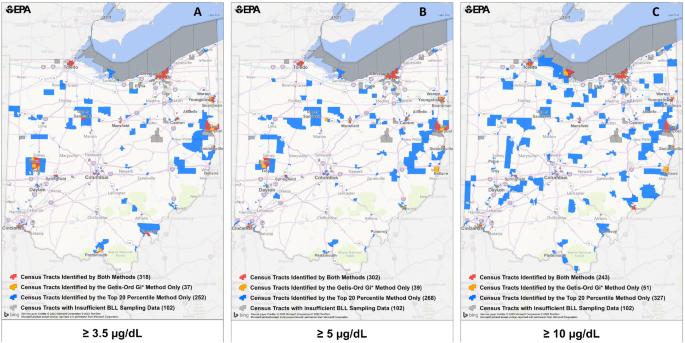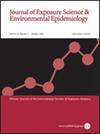Identification of high lead exposure locations in Ohio at the census tract scale using a generalizable geospatial hotspot approach
IF 4.1
3区 医学
Q2 ENVIRONMENTAL SCIENCES
Journal of Exposure Science and Environmental Epidemiology
Pub Date : 2024-04-04
DOI:10.1038/s41370-024-00666-x
引用次数: 0
Abstract
Lead is a persistent, ubiquitous pollutant whose historical sources have been largely addressed through regulation and voluntary actions. The United States (U.S.) has achieved significant decreases in children’s blood lead levels (BLL) over the past 40 years; however, there is no known safe level of Pb exposure. Some communities continue to be disproportionately impacted by exposure to Pb, including Black children and families living in older homes. To identify Ohio (OH) census tracts with children exposed to Pb and evaluate potential exposure determinants. We obtained individual children’s blood Pb data from 2005–2018 in OH. The percent of children with elevated BLL (EBLL) was calculated for OH census tracts using three blood Pb reference values (3.5, 5, and 10 µg/dL). Getis-Ord Gi* geospatial hotspot or top 20th percentile methodologies were then applied to identify “hotspots.” Findings across multiple time periods and blood Pb reference values were evaluated and compared with existing Pb exposure indices and models. Consistency was observed across different blood Pb reference values, with the main hotspots identified at 3.5 µg/dL, also identified at 5 and 10 µg/dL. Substantial gains in public health were demonstrated, with the biggest decreases in the number of census tracts with EBLL observed between 2008–2010 and 2011–2013. Across OH, 355 census tracts (of 2850) were identified as hotspots across 17 locations, with the majority in the most populated cites. Generally, old housing and sociodemographic factors were indicators of these EBLL hotspots. A smaller number of hotspots were not associated with these exposure determinants. Variables of race, income, and education level were all strong predictors of hotspots. The Getis-Ord Gi* geospatial hotspot analysis can inform local investigations into potential Pb exposures for children living in OH. The successful application of a generalizable childhood blood Pb methodology at the census tract scale provides results that are more readily actionable. The moderate agreement of the measured blood Pb results with public Pb indices provide confidence that these indices can be used in the absence of available blood Pb surveillance data. While not a replacement for universal blood Pb testing, a consistent approach can be applied to identify areas where Pb exposure may be problematic.

利用可推广的地理空间热点方法,在俄亥俄州人口普查区范围内确定高铅暴露地点
背景铅是一种持久性的、无处不在的污染物,其历史来源主要是通过监管和自愿行动来解决的。在过去的 40 年中,美国儿童的血铅含量(BLL)已显著下降;然而,目前尚无已知的铅暴露安全水平。目标确定俄亥俄州(OH)有儿童暴露于铅的人口普查区,并评估潜在的暴露决定因素。方法我们获得了俄亥俄州 2005-2018 年的儿童血铅数据。我们使用三个血铅参考值(3.5、5 和 10 µg/dL)计算了俄亥俄州人口普查区血铅含量升高(EBLL)儿童的百分比。然后采用 Getis-Ord Gi* 地理空间热点或前 20 百分位数方法来确定 "热点"。结果在不同的血铅参考值中观察到了一致性,主要热点被确定为 3.5 µg/dL,也被确定为 5 和 10 µg/dL。在 2008-2010 年和 2011-2013 年期间,出现 EBLL 的人口普查区数量降幅最大。在整个俄亥俄州,355 个普查区(共 2850 个)被确定为 17 个地点的热点,其中大多数位于人口最稠密的城市。一般来说,旧住房和社会人口因素是这些 EBLL 热点的指标。少数热点地区与这些暴露决定因素无关。种族、收入和教育水平等变量都是热点的有力预测因素。影响声明Getis-Ord Gi*地理空间热点分析可为当地调查俄亥俄州儿童潜在的铅暴露提供信息。在人口普查区范围内成功应用可推广的儿童血铅方法可提供更易于操作的结果。测得的血铅结果与公共血铅指数基本一致,这使人们相信,在没有可用的血铅监测数据的情况下,这些指数是可以使用的。虽然不能取代普遍的血铅检测,但可以采用一致的方法来确定可能存在铅暴露问题的地区。
本文章由计算机程序翻译,如有差异,请以英文原文为准。
求助全文
约1分钟内获得全文
求助全文
来源期刊
CiteScore
8.90
自引率
6.70%
发文量
93
审稿时长
3 months
期刊介绍:
Journal of Exposure Science and Environmental Epidemiology (JESEE) aims to be the premier and authoritative source of information on advances in exposure science for professionals in a wide range of environmental and public health disciplines.
JESEE publishes original peer-reviewed research presenting significant advances in exposure science and exposure analysis, including development and application of the latest technologies for measuring exposures, and innovative computational approaches for translating novel data streams to characterize and predict exposures. The types of papers published in the research section of JESEE are original research articles, translation studies, and correspondence. Reported results should further understanding of the relationship between environmental exposure and human health, describe evaluated novel exposure science tools, or demonstrate potential of exposure science to enable decisions and actions that promote and protect human health.

 求助内容:
求助内容: 应助结果提醒方式:
应助结果提醒方式:


